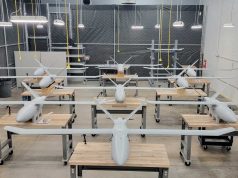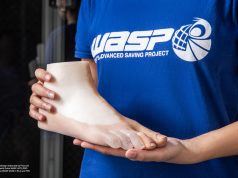WASP announces the completion of Trabeculae Pavilion, a lightweight architecture completely 3D printed that fuses advancements in 3D printing with bio-inspired computational design.
The synergy of design, material and manufacturing technologies allowed the conceptualization of an innovative construction technique based on an additive process which builds architectural forms conceived with a load-responsive material organization. Five WASP printers worked H24. The fabrication process of the building components was based on four DeltaWASP 4070 and a DeltaWASP 60100, a WASP printer farm installed in the laboratories of Department ABC of Politecnico di Milano, where parallel production processes have been run for a continuous production of 4352 hours in total. The use of WASP Spitfire extruder was introduced for the first time to shape stiff components within a minimized amount of time.
The prototype is the result of the doctoral research of Roberto Naboni who has designed and developed the pavilion at Politecnico di Milano, together with a team of specialists in experimental design and construction. The project looks into 3D Printing for answers to the emerging problem of scarcity in material resources. The design is based on a computational process that finds inspiration in Nature, specifically in the materialization logics of the trabeculae, the internal cells that form the bone microstructure. From this investigation, custom algorithms have been developed to support the creation of a cellular load-responsive structure with continuous variations in sizing, topology, orientation and section, in order to maximize material efficiency.
“The last decades have witnessed an exponential growth in the demand of raw materials due to the rapid urbanization and industrialization of emerging economies. This research looks at biological models and at the opportunities offered by the new additive production technologies in order to find sustainable solutions to the exploitation of materials. Our objective is to explore a new model of construction: advanced, efficient and sustainable” declare Roberto Naboni, Architect and currently Assistant Professor at University of Southern Denmark (SDU).
The built pavilion is a load-responsive shell composed by 352 components covering a total area of 36 square meters, shaped additively by a 112 kilometers-long extrusion of a high-resistance biopolymer, specifically developed with industrial partner FILOALFA® to elevate Fused Deposition Modelling (FDM) to construction purposes. The innovative methods involved for the design allow for an efficient material distribution at multiple scales, which permits an extremely resistant and lightweight structure with a variable weight to area ratio of 6 to 10 kg/m2 – about ten times lighter than typical construction techniques with comparable mechanical performance. Beyond its technical features, the pavilion is an outstanding expression of a tectonic system conceived with and for 3D Printing, which enables multiple high-res optimization logics with the precision of a tenth of a millimeter.
Subscribe to our Newsletter
3DPResso is a weekly newsletter that links to the most exciting global stories from the 3D printing and additive manufacturing industry.























